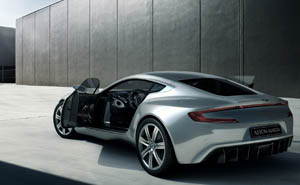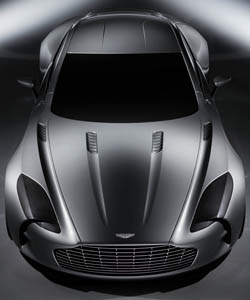Geneva Motor Show: Aston Martin unveils One-77 super car
04 Mar 2009|5,446 views
Chassis no.1 will be on display as an expose throughout the show detailing the quintessence of Aston Martin engineering and design expertise.
For Aston Martin's Chief Executive, Dr Ulrich Bez, revealing the One-77's secrets is a proud moment: "Right from the very beginning of the project the vision for One-77 was very simple: It had to combine high-technology with hand-built craftsmanship, and demonstrate the unique capabilities and passion of our designers, engineers and technical partners.
"Quite simply it had to be the ultimate expression of Aston Martin. As you can now see, we have achieved that goal in magnificent style."
Chris Porritt, One-77 Programme Manager, continued: "We wanted to create something that wows you as much when you see what's under the skin as the exterior styling itself. We started by identifying the most technologically exciting front-engined, rear-wheel drive cars in the world: those from the DTM race series. We then applied the principles and technology that feature heavily in their design and translated it to a road car application."
 |
Employing the classic formula of double wishbones at each corner, the One-77 features inboard suspension front and rear, with pushrods employed to transfer vertical suspension movements to the horizontally mounted spring/damper units. A practice taken directly from racing car design, the main advantages of inboard suspension are a reduction in unsprung weight and the ability to package the suspension components more effectively.
The dampers are fully adjustable and feature advanced Dynamic Suspension Spool Valve (DSSV) technology; a world-first for a road car application. These special valves are state-of-the-art even at the highest levels of motorsport, and use high-precision machined components to enable the shock-absorbing characteristics of the damper to be changed without having to remove them from the car, as is the norm.
Underlining the truly bespoke nature of the One-77, once delivered to its owner, the car's suspension characteristics will be precisely set-up by Aston Martin engineers to suit their exact requirements, from settings suitable for the ultimate long-distance GT, to a machine capable of conquering the Nürburgring Nordschleife.
 |
Thanks to the adoption of a dry-sump oil system the engine is mounted 100 mm lower than in any previous V12-engined Aston Martin road car, which helps keep the One-77's centre-of-gravity as low as possible.
To further aid agility and endow the One-77 with progressive handling and stable, predictable on-limit behaviour, the engine is also mounted 257 mm aft relative to the front wheel centreline. In so doing the front-mid-engined layout shared by all of Aston Martin's current road car range has been taken to a new level.
The One-77's magnificent power unit is an extreme evolution of the 6.0-litre V12 engines fitted to the DBS, DB9 and new V12 Vantage models. Like the collaboration with MTC for the build of the chassis, Aston Martin has chosen a world-leading partner with which to develop the motor: legendary engine builders, Cosworth.
It has proved to be the perfect collaboration, as Chris Porritt explains.
"Our brief to the engine team was for them to take the 6.0-litre V12 as far as it could go, both in terms of output and weight reduction. The targets were a power output of no less than 700 bhp with a 10 percent reduction in engine mass. Incredibly, the Aston Martin and Cosworth engineers achieved a mass reduction of some 25 percent, and although we've yet to complete the final engine calibration work, I'm confident we'll see in excess of 700 bhp. It's an awesome accomplishment, but one that's typical of the One-77 project, for it has consistently brought out the very best in everyone involved."
Wearing Pirelli P Zero Corsa tyres (255/35 ZR20 front, 335/30 ZR20 rear) developed specifically for the One-77, all 700+ bhp is transmitted to the road through the rear wheels via a new six-speed gearbox. Controlled via column-mounted paddles behind the steering wheel, this robotised sequential manual is a new generation of Aston Martin's familiar transmission.
Though it is made specifically for the One-77 and features specially strengthened internals to cope with the tremendous power and torque, the lessons learned in its development will ultimately find their way into the company's series production models.
Carbon Ceramic Matrix brake technology has been used for the One-77's braking system. The internals of the callipers have been re-engineered to transmit less heat from the brake pads into the brake fluid, while the discs themselves have been developed to ensure the maximum possible contact area between the face of the disc and the brake pads for improved stopping power.
Due to the One-77's increased performance, special attention has also been paid to brake cooling, as the brakes have less time to cool between bursts of acceleration.
With a projected weight of 1,500 kg the One-77 will occupy the very highest echelons of road car performance. Top speed is confidently predicted to be in excess of 320 km/h, with a 0-100 km/h time in approximately 3.5sec.
Chassis no.1 will be on display as an expose throughout the show detailing the quintessence of Aston Martin engineering and design expertise.
For Aston Martin's Chief Executive, Dr Ulrich Bez, revealing the One-77's secrets is a proud moment: "Right from the very beginning of the project the vision for One-77 was very simple: It had to combine high-technology with hand-built craftsmanship, and demonstrate the unique capabilities and passion of our designers, engineers and technical partners.
"Quite simply it had to be the ultimate expression of Aston Martin. As you can now see, we have achieved that goal in magnificent style."
Chris Porritt, One-77 Programme Manager, continued: "We wanted to create something that wows you as much when you see what's under the skin as the exterior styling itself. We started by identifying the most technologically exciting front-engined, rear-wheel drive cars in the world: those from the DTM race series. We then applied the principles and technology that feature heavily in their design and translated it to a road car application."
 |
Employing the classic formula of double wishbones at each corner, the One-77 features inboard suspension front and rear, with pushrods employed to transfer vertical suspension movements to the horizontally mounted spring/damper units. A practice taken directly from racing car design, the main advantages of inboard suspension are a reduction in unsprung weight and the ability to package the suspension components more effectively.
The dampers are fully adjustable and feature advanced Dynamic Suspension Spool Valve (DSSV) technology; a world-first for a road car application. These special valves are state-of-the-art even at the highest levels of motorsport, and use high-precision machined components to enable the shock-absorbing characteristics of the damper to be changed without having to remove them from the car, as is the norm.
Underlining the truly bespoke nature of the One-77, once delivered to its owner, the car's suspension characteristics will be precisely set-up by Aston Martin engineers to suit their exact requirements, from settings suitable for the ultimate long-distance GT, to a machine capable of conquering the Nürburgring Nordschleife.
 |
Thanks to the adoption of a dry-sump oil system the engine is mounted 100 mm lower than in any previous V12-engined Aston Martin road car, which helps keep the One-77's centre-of-gravity as low as possible.
To further aid agility and endow the One-77 with progressive handling and stable, predictable on-limit behaviour, the engine is also mounted 257 mm aft relative to the front wheel centreline. In so doing the front-mid-engined layout shared by all of Aston Martin's current road car range has been taken to a new level.
The One-77's magnificent power unit is an extreme evolution of the 6.0-litre V12 engines fitted to the DBS, DB9 and new V12 Vantage models. Like the collaboration with MTC for the build of the chassis, Aston Martin has chosen a world-leading partner with which to develop the motor: legendary engine builders, Cosworth.
It has proved to be the perfect collaboration, as Chris Porritt explains.
"Our brief to the engine team was for them to take the 6.0-litre V12 as far as it could go, both in terms of output and weight reduction. The targets were a power output of no less than 700 bhp with a 10 percent reduction in engine mass. Incredibly, the Aston Martin and Cosworth engineers achieved a mass reduction of some 25 percent, and although we've yet to complete the final engine calibration work, I'm confident we'll see in excess of 700 bhp. It's an awesome accomplishment, but one that's typical of the One-77 project, for it has consistently brought out the very best in everyone involved."
Wearing Pirelli P Zero Corsa tyres (255/35 ZR20 front, 335/30 ZR20 rear) developed specifically for the One-77, all 700+ bhp is transmitted to the road through the rear wheels via a new six-speed gearbox. Controlled via column-mounted paddles behind the steering wheel, this robotised sequential manual is a new generation of Aston Martin's familiar transmission.
Though it is made specifically for the One-77 and features specially strengthened internals to cope with the tremendous power and torque, the lessons learned in its development will ultimately find their way into the company's series production models.
Carbon Ceramic Matrix brake technology has been used for the One-77's braking system. The internals of the callipers have been re-engineered to transmit less heat from the brake pads into the brake fluid, while the discs themselves have been developed to ensure the maximum possible contact area between the face of the disc and the brake pads for improved stopping power.
Due to the One-77's increased performance, special attention has also been paid to brake cooling, as the brakes have less time to cool between bursts of acceleration.
With a projected weight of 1,500 kg the One-77 will occupy the very highest echelons of road car performance. Top speed is confidently predicted to be in excess of 320 km/h, with a 0-100 km/h time in approximately 3.5sec.
Latest COE Prices
April 2025 | 1st BIDDING
NEXT TENDER: 23 Apr 2025
CAT A$97,724
CAT B$117,899
CAT C$68,782
CAT E$117,002
View Full Results Thank You For Your Subscription.






















